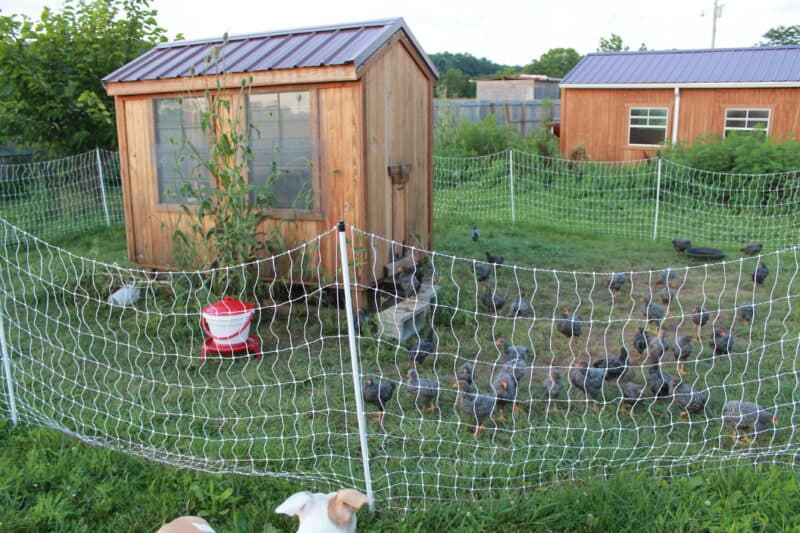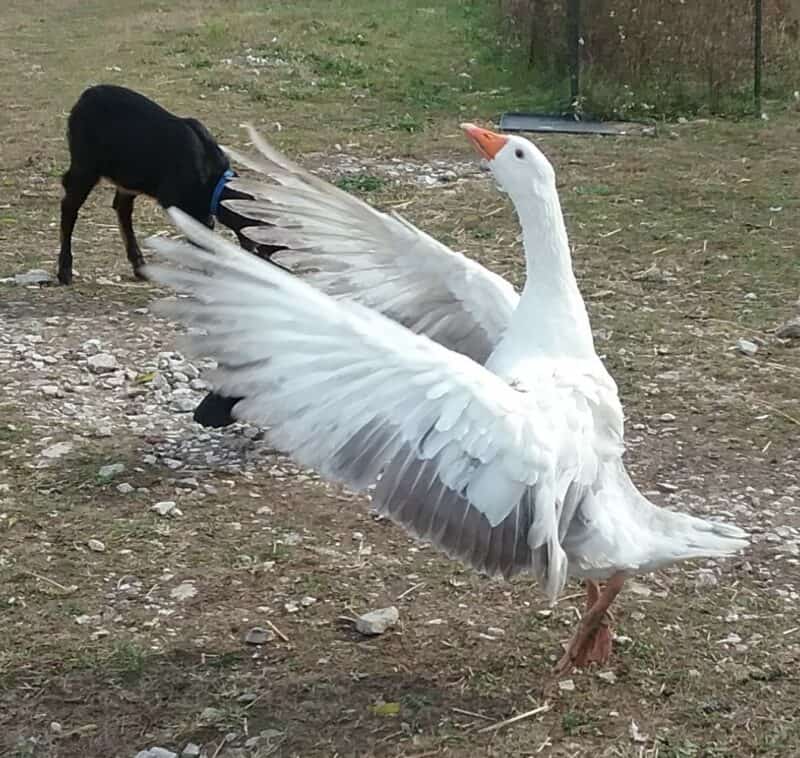There are few words that evoke as much fear to chicken owners as “foxes in the henhouse.” These clever canids are stealthy and intelligent. Persistence and the ability to work out problems would get them a job in any corporate office.
That’s not what you want to hear when you’re trying to protect your flock, however.
Don’t worry, there are lots of things you can do to protect your chickens from foxes. We’re sharing our best tips so that you and your ladies can rest easy.
Understanding the Fox
The fox has a reputation for being cunning. Aesop’s fables, the Brothers Grimm, and many Native American legends feature the “clever” fox. Consider the saying “wily like a fox.”
There are good reasons that foxes have this reputation. They survive by outwitting other predators and reasoning through problems. Plus, they’re intensely curious by nature.
I always loved the old folk song about the fox:
The fox went out on a chilly night,
he prayed to the Moon to give him light,
for he’d many a mile to go that night
before he reached the town-o, town-o, town-o,
he had many a mile to go that night
before he reached the town-o…
However, when it comes to your chickens that may be a bit too close for comfort.
Know Your Foe
To tackle a fox problem, you need to get to know them. Foxes are most active in the early morning and at dusk. Keeping your chickens secure during this time goes a long way to keeping them safe. However, in spring when foxes are feeding kits they may hunt during the day.

A fox typically catches one bird at a time. You might have a bird just vanish with no trace or maybe just a few tell-tale feathers left behind.
Foxes are clever enough that they will stake out your property and get to know your routines. Then, they’ll wait until they’re sure you aren’t around before striking.
Foxes won’t eat on-site but take the kill back to their den for their family. If you have a massive slaughter with many animals killed at one time or a messy kill with evidence of feeding on-site, that would probably be a raccoon.
The primary food for foxes in the wild are rodents. Mice, voles, and rabbits are the most common foods they eat. But a fox is actually an omnivore and will also eat berries and fallen fruits.
As a wildlife rehabilitator and homesteader, I raise and release fox kits on my farm each year. In addition, as a homesteader, I usually have two or three chicken tractors for poultry and free-range geese.
I can tell you honestly that the foxes I rehabilitate have not caused me any issues with my poultry. They usually can’t wait to get away from me and head towards the woods.

Still, it’s possible that if you have a heavily wooded lot or you sit against the wood, a vixen might set up her den near your property to use your flock as a ready meal.
Because they’re less likely to be a problem than some other mammals, when I plan my poultry housing I mainly focus on making them raccoon safe – which is also fox safe.
Protecting Your Chickens on Two Fronts
To protect your chickens from foxes you need a sturdy henhouse or chicken tractor. Fencing also works to create a secure nighttime area. I use a combination of both.
You don’t have to do both, but your chickens will be much safer if you do. You can just do one or other and it will still go a long way. Each has pros and cons.
Chicken Houses and Tractors
A good solid chicken house with hardware cloth securely covering the windows is predator-proof, providing that you close and secure the hatch door every night. The downside is that this type of construction is either hard to move or in a permanent location.
Chicken tractors are nice because you can move the birds to fresh grass every day. The downside of the tractor is that it’s by nature of design much harder to secure. The bottom of the tractor is subject to animals digging under it and grabbing your chickens.

Above is a very basic chicken tractor. You can see it uses hardware cloth which overlaps so there are no seams or weak spots. In addition, the underside of the house part is also wire. This is a heavy smaller coop I use for young birds.
Good Fencing
Fencing is the best option for keeping foxes from getting near your henhouse. If you have fencing around your henhouse you can protect your chickens at all hours of the day.
Fencing works as double security if you lock your girls up in a house at night.
Building a fence is a tough job and costs money for materials, but I think it’s the best way to go when the alternative is losing chickens to a predator.
If you have to keep buying new chicks and feeding them until they start laying, only to have them killed, you’re going to be without eggs for some time.
It’s best to get your chickens into a safe enclosure where they can have some freedom to roam around and have a happy but safe life.
The Right Fence Design
The best fences are six feet tall. Foxes are good climbers, so the fence should slope outward to keep them from climbing over the top. Use heavy welded wire for your fence.
Never use chicken wire. Chicken wire is useless for keeping out predators. It only works to keep chickens in.
Foxes, being canids, are diggers. Therefore it’s wise to dig your fence down 12-20 inches below ground.
If you have rocky or sandy soil you may think about using a predator apron. This device is simply a flat layer of heavy wire laid flat along the ground. The fox will go up next to the chicken house and attempt to dig but will hit the wire and get discouraged.
Just an FYI, another canid, the coyote, is known for tunneling and won’t be put off by the predator apron.
Electric Fencing
Electric fencing works well to deter a fox. Netting works much better than strands.
The electric netting prevents foxes from tearing through or going under a strand to get to the henhouse. Electric netting works well for providing outdoor space and is easy to move to fresh grass.
I have used netting around a wooden chicken house so the birds could go outside during the day. This strategy works quite well. This chicken house is on skids – a chicken tractor on steroids – so the whole system can be moved occasionally to fresh pasture.

Add Automatic Door Openers
One of the things that was hard for me when I was teaching was in the winter I would go out and feed my animals in the dark before I left for work.
If you have a work schedule that keeps you from letting your girls in and out when you want to, you may want to install an automatic door opener on the henhouse.
Depending on the model you use you can have them on a timer or sensitive to light. One on a timer will allow you to wait for a bit after the sun rises. This will give your hens some additional protection before going outside.
6 Other Methods to Discourage Foxes
On top of a chicken tractor and a good fence, there are several other techniques you can use to keep foxes from getting in the henhouse.
1. Flashing Lights
In rural areas flashing lights may work to scare foxes away. Studies have shown that red lights work best because they are perceived as eyes.
These don’t work so well in urban areas where foxes are accustomed to streetlights and traffic signals.
In addition, you can get lights that emit sounds that compound the scare factor. Loud noise can serve to frighten them. You can also try a radio on an all-night talk show. However, that would only disrupt their activities temporarily.
2. Livestock Guard Animals
There are many types of livestock guard animals that will protect your henhouse from foxes and just by their presence they can scare off predators.
Livestock Guardian Dogs (LGD) are popular animals to have on the farm. Many breeds are quite popular, such as the Great Pyrenees. This is what I have on my farm, and while both of mine are rescues, they took to protecting us right away.
Other popular breeds for protecting chickens are the Anatolian Shepherd, Mastiff, and Kangal. These dogs are highly protective of their “flock” and will chase off predators who come near.
3. Unusual Guard Animals
Guard Animals are not limited to dogs. Hooved animals such as donkeys and llamas will fiercely protect their territory and make good guard species. Hooved helpers are more likely to protect their territory versus actually protecting the other animals within it, but the end result is the same.
4. Have a Mixed Poultry Flock
Having a mixed poultry flock that includes geese is a smart strategy. Geese are fabulous guard animals and will faithfully protect chickens in their territory.
While a goose may also be seen as prey by a fox, they’re able to fight back. A goose is a pretty formidable animal and can hold its own even against canids. My goose, Goober, has the dogs pretty intimidated and stands watch at the gate.

5. Landscaping Techniques
Keeping areas around barns and gardens mowed and clear of debris will help keep predators from approaching.
Foxes like rock walls, thick stands of trees, and brush piles in order to hide and sneak up on unsuspecting prey.
Foxes are related to dogs and, like dogs, are very smart. You need to be smarter by making your property difficult to hunt in!
6. Practice Good Timing
If you want to free-range your chickens, do so from mid-morning to mid-afternoon. Chickens are pretty responsive to routines. Don’t feed your chickens in the morning but let them forage during the day.
Then, at four o’clock, go out, call the chickens, and put food in their dishes in the house. They’ll learn to come at that time and you can lock them up. This will put them in safety before foxes start hunting.
The bottom line is that you need to practice diligence to keep foxes out of the henhouse. Make sure your poultry houses are secure and that you monitor your chicken’s outside time. This will ensure that you don’t have any conflict with foxes and other predators.












